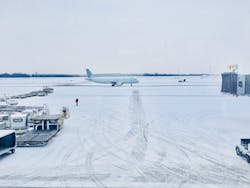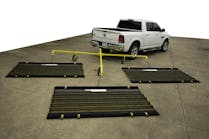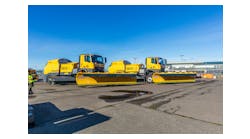Use the Power of Data to Keep Runways Clear During Winter Weather
In the ongoing battle between airport operations and winter weather, airports always want to err on the side of caution.
Regardless of the size of the airport, safety is the No. 1 concern, and ice, snow and frost can all impact both the safety and the efficiency of essential airport operations. When it comes to snow removal, the biggest priority is keeping ice from forming because once ice forms on the runway surface, it takes a significant amount of work to return to dry pavement. Airports have to prepare for winter weather events with well-choreographed plans to deal with whatever might happen.
Whether determining the equipment and materials necessary for adequate snow and ice removal, closing runways or cancelling flights altogether, airport decision-makers need accurate and reliable weather information to prioritize the safety and efficiency of all operations. But how do airports get weather intel leading up to and during snow removal?
The aviation industry has been investing significantly into technologies aimed at tackling weather mitigation. Recent reports reveal the global airport snow and ice management equipment market is currently valued at more than $2 billion and is estimated to grow by nearly 3 percent from 2018-2026. Beyond snow blowers, plows, brooms, sprayer trucks and de-icing chemicals, advanced airport weather technologies are now delivering the data that helps keep airport runways, taxiways and ramps safe during the winter snow and ice.
Need for Stationary Runway Weather System Technology
The Federal Aviation Administration heavily regulates the snow removal process. Its 60-plus-page Airport Winter Safety and Operations advisory circular advises airport operators on how to develop a snow and ice control plan and tells them how to conduct runway friction surveys to determine if it’s safe for a plane to land or take off.
The FAA requires every airport that receives more than six inches of snow per year to create a snow and ice control plan and a committee to create guidelines for winter operations. The administration considers a runway to be contaminated when standing water, snow, ice or slush are present because those conditions can lead to hydroplaning, making it difficult for a plane to take off or land safely.
Because winter weather impacts runways and taxiways in a different manner than it impacts the atmosphere, measuring specific runway conditions is critical to airport safety. As such, accurate, real-time weather monitoring of the runways and taxiways is one of the most cost-effective methods decision-makers utilize to ensure safe, continuous airport operations.
Enter runway and weather sensors.
From embedded in-pavement sensors and subsurface temperature probes to atmospheric sensors, runway weather technologies provide airport staff with near real-time critical information to make informed decisions about treating, clearing and maintaining various airport surfaces.
In-Pavement Sensors
These embedded sensors measure the pavement surface temperature, the surface state, and the presence and concentration of chemical present to help determine when ice will start to form. They are often embedded along a runway, generally where planes touch down and take off and at various points in between those positions. Additionally, these sensors can also be installed to monitor the surface conditions on taxiways.
Subsurface Temperature Probes
Subsurface temperature probes provide decision-makers with a crucial understanding of what’s going on underneath the pavement’s surface. These sensors are designed to be installed below the surface at a recommended depth of 12 inches. These probes measure the ground temperature and if thermal energy exists that could help prevent icing, leveraging that information to predict future pavement surface temperatures and whether snow will begin to stick or if frost or ice will start forming.
Atmospheric Sensors
Atmospheric sensors are designed to provide measures of air temperature, dew point, precipitation, wind speed and direction, visibility and other atmospheric constituents. Atmospheric conditions have a significant impact on pavement conditions.
Before the Storm
Bad weather is rarely a surprise to airport decision-makers. Before most people even know a storm is coming, airport teams have prepared and planned for the worst. Whether assembling the snow and ice team, getting equipment ready or monitoring winter weather, snow and ice maintenance requires a significant amount of organization to ensure the safety and efficiency of airport operations.
With 24/7 access to weather information through various providers, such as National Oceanic and Atmospheric Administration (NOAA) and the National Weather Service, airport staff are able to effectively watch the weather in advance of any winter storm. Flexible and customizable to an airport’s particular needs, forecasts are typically delivered every day, including daily outlooks, 24-hour forecasts and 2-5 day forecasts.
Forecasting conditions is critical to performing winter maintenance operations that reduce the risks posed by hazardous runway conditions. Recognizing when to prepare for an icing event or a winter storm can save money and resources, and modern software can provide a traditional atmospheric weather forecast, as well as a prediction of runway surface conditions.
By combining current observations from the stationary runway weather information system (RWIS) and predicted weather conditions, software solutions are able to provide a baseline for the forecast. This means decision-makers at the airport can quickly determine how well a forecast is performing and whether any short-term adjustments are needed to make confident decisions about the effects of winter weather.
When airport crews know a winter weather event is coming in, providing it does not begin with rain that would wash the chemical away, they can pretreat the runway to prevent snow and ice from bonding to the runway surface and make it easier to remove. As such, knowing what the atmospheric parameters, pavement temperature and surface state will be at any given moment is of crucial importance — and forecasting helps provide reliable weather data in advance of the storm.
During a Winter Weather Event
During winter weather events, runway capacity slows down, baggage handlers have to exercise an additional level of caution, planes have to be de-iced and runways may need to be shut down periodically so plows, snowblowers and brooms can get them back to a safe state. It’s crucial that ground crews and operations teams work in coordination to minimize any delays. Snowstorms can impact an airport’s capacity for handling arriving and departing aircraft, which can result in cancelled flights. Real-time, accurate and reliable weather information is vital to make decisions surrounding winter weather-related challenges.
Airports also require intelligence surrounding how the runway behaves in these circumstances. The effectiveness of de-icing chemicals is determined by the surface temperature and not the air temperature. With RWISs consisting of in-pavement sensors, subsurface temperature probes and a full suite of atmospheric sensors, airport decision-makers can collect and process both weather and runway data that provides accurate and reliable information to improve the timing of airport maintenance de-icing applications.
The FAA’s Takeoff and Landing Performance Assessment (TALPA) initiative reduces the risk of runway overruns by providing airport operators with a method to accurately and consistently determine runway conditions when a paved runway is not dry. Using a friction wheel is essentially subjective, but new software systems combining mobile sensors that can be mounted on any snowplow and smartphone applications are better aligned with TALPA procedures than those provided by friction measurement devices to provide FAA-compliant runway condition reporting. This makes assessment and reporting faster and the job of the inspector easier.
Mobile and RWIS sensors produce runway condition data and assessment to support decision-making in real time during any kind of weather event. Advances in technology allow different inspectors to consistently assess and report on runway conditions, freeing them to concentrate on other condition factors, such as foreign object damage risks, accelerating the normal GRF workflow. This minimizes the amount of time inspectors have to spend on runways making surface assessments, which improves airport capacity and helps to maintain normal operations, even in the midst of the most severe winter weather.
The ultimate goal for any airport is to remain open, abide by FAA safety standards, stay ahead of the storm, and stay as safe. The importance of incorporating runway weather technologies to deliver key information in a timely fashion cannot be overstated. The essential data allows airport decision-makers to plan accordingly to pretreat runways and stay ahead of winter weather both before and during a storm.






